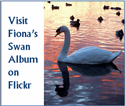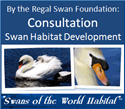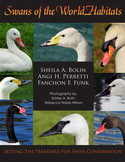Ask the Swan Specialist
Date: 18 November 2013
GENERAL SWAN FAQ’s
What do swans eat?
Swans are grazing birds and will grasses and aquatic vegetation. They feed from the muck at the bottom of the pond or lake. In a captive setting, aquatic vegetation and grasses may not be readily available. Therefore, the swans must be fed supplementally using lettuce, and a mixture of 50% cracked corn and 50% poultry layer pellets. The cracked corn acts as a filler to keep the swans feeling full, but also providing the essential nutrient Vitamin A. Vitamin A is a critical requirement in the swan’s food source because without this vital nutrient, neurological problems can result.
Poultry layer pellets provide the swans with critical micronutrients, vitamins and minerals such as calcium, phosphorous, potassium, etc. Lettuce provides the swans with a supplemental vegetation. Bread can be fed to a swan as a treat, but too much bread can alter the swan’s blood sugar. Bread provides absolutely no nutrient value which can result the swan starving from malnutrition. Chocolate, left-over foods and many other items off the plate should never be given to swans or other wildlife. Just because a food is suitable for humans, does not mean that it is suitable for a swan. In fact, many of the foods that humans eat can be detrimental to a swan’s health and could result in toxicity which can kill the bird. Other toxins include various poisonous plants, insecticides, fertilizers, pesticides and fungicides that should be eliminated from areas where the swans reside or feed.
Can swans survive extreme temperatures or inclement weather?
Wild swans can fly during the migratory season to escape extreme temperatures. However, if there is something wrong with a wild swan or if a swan is captive and cannot fly (has been pinioned or clipped so that it cannot fly), the swan is in extreme jeopardy. If a pond or lake should freeze, it could cause the swan to drown, starve from lack of food resources or become stranded on the ice allowing a predator to walk onto the ice and attack the swan. Ponds or lakes should have aerators for water circulation and oxygenation during the summer months and an aerator/bubbler/de-icer to prevent the pond or lake from freezing during the winter. The swans should be fed several times daily to ensure that they have enough food to survive the winter. However, it the weather is extreme, regardless of the freezing of the pond or lake, the swans should be brought inside to a garage (free from chemicals, gasoline or dangerous fumes), a shed or barn with adequate ventilation, safe heating, enclosed completely and safe from predator access, as well as access to fresh water and food daily and free from pests such as ants and rats.
During hurricanes or other extreme wind events, captive swans should be brought inside if the winds reach 40+ mph. Heavy winds can cause the swans to be blown into structures or objects that can fracture their necks or wings, or hit by flying debris.
Why do swan parents nip at the young or abandon the cygnets?
If something is wrong with a cygnet, i.e., sick or injured, the parent swans may abandon or even try to kill the young bird. This may seem cruel to humans but it is nature. The parent swans know when something is wrong with the young bird and know that its survival may endanger the rest of the cygnets or family. Nature does not waste time coddling something sick or injured. To do so is detrimental to the species because predators can be led back to the rest of the family, a disease could spread through the flock and too much time and energy is wasted trying to protect something that will probably die anyway.
Another reason that parents nip the young birds is to remove them from the habitat for preparation for the next breeding season. Cygnets begin to turn white in color at approximately 6-8 months of age, reaching their full adult coloration around one year of age. Once the cygnets turn white, the parents seem not to recognize the cygnets and treat them as rivals. The cygnets may cry out loud and try to pursue the parents, not understanding exactly what is occurring. Equate this scene to a young adult human being told that they must leave the house and find a job! In nature, the parents will nip and chase the juvenile birds until they get the message to meet up with other juveniles to find an eventual mate and start their own family.
How many swan species exist?
There are seven species of swans and one subspecies: Mute Swans (UK-Europe), Whooper Swans (Eurasia), Trumpeter Swans (North America), Tundra Swans (North America), Black Swans (Australia), Black-Necked Swans (South America) and Coscoroba Swans (South America) are the species.
The subspecies is the Bewick Swan which is the Eurasian subspecies of the North American Tundra Swan.
Swans from the Northern Hemisphere are white feathered in color while Southern Hemisphere Swans have some black coloration on their feathers.
What are Male Swans called?
Male Swans are called Cobs from the large Knob on their beaks. Knob came from the Old German word “Knopf” which meant Knob and then someone shortened it to cob.
What are Female Swans called?
Female Swans are called pens from the Old English term “pennae” which means penned. This penned term comes from the way that the female swan carries her swans in a penned-back manner.
Do swans mate for life?
Usually, swans mate for life but not always. There are many issues that determine if mating is for life. The individual swan, the age of the swan, the swan species and the successful breeding and raising of cygnets determines if the swan pair will stay together for life. The Whooper Swans have a 6% divorce rate.
If the male swan dies, the female swan will usually try and re-pair with another male swan. However, there are no guarantees that she will take on another mate. If the female dies, the male may or may not re-pair with another mate. In fact, usually, a male will go about his life without re-pairing.
Many times, especially in captive settings, humans will try to compare the swans with a human that has lost its mate. The humans will intervene and try to get the swan to accept a new mate. Again, this does not always work and usually results in a lot of time and money being spent and having to find another home for the new swan. Swans and wildlife may grieve, but they do not grieve for such long periods as humans. To do so would be detrimental to the individual animal, bird or species. Grieving may be present, but eventually and quickly, the wildlife member will go about their business to feed, care for its cygnets or try to find a mate.
At what age do swans begin mating and producing offspring?
Most research states that a juvenile swan is approximately three years of age before it can produce viable young. However, in our research, we have seen cygnets as early as one year of age practicing mating behavior and producing eggs at two years of age. The viability of the eggs and cygnets does not necessarily depend on the age of the swans, but rather if the young parents understand how to take care of a baby swan. Some young swan parents do a tremendous job of taking care of young while others appear to have absolutely no idea what to do with an egg or a hatchling.
What are swan babies called?
Cygnets
How many cygnets can a swan pair produce?
Most swan species produce a brood of 1-13 cygnets a year. However, Black Swans, have two breeding seasons producing 1-8 cygnets twice a year.
Why are some Mute Swan cygnets white instead of gray/taupe in color?
Many years ago, someone in Eastern Europe tried to produce an albino swan, meaning one that was all white and no coloration on the beak or feet. Through many in-breedings, the only coloration they could produce resulted in a leucistic color form. Leucism is just a lighter color or variant color form. Although all Mute Swans (Cygnus olor) are Mute Swans, swan keepers designate them as either Royal Mutes or Polish Mutes.
The Royal Mute Swans have reddish/orange bills and black legs and feet. These Mute Swan parents produce cygnets that are taupe/grey in color upon hatching with black legs and feet. The cygnets turn white at approximately 6-8 months of age.
Polish Mute Swans have orange bills and taupe colored legs and feet. These Mute Swan parents produce cygnet that are white in color upon hatching with taupe colored legs and feet.
There is nothing wrong with the cygnets and there is no reasoning as to if or when Mute Swans will produce this leucistic color form. If either or both parents carry the leucistic gene, then sometime in their breeding period, they will most likely produce Polish Mute cygnets.
Are Mute Swans deaf?
Mute Swans are not deaf, but the less vocal of the swan species and thus, known as Mutes. The windpipe of the Mute Swan acts as a long tube that bifurcates, (splits) into the swan’s lung and therefore, the straight shape does not allow for vocalizations that are present in the Trumpeter Swan. Trumpeter Swans have windpipes that convolute (fold) as they make their way down into the lungs which helps produce the loud trumpet-like sounds the Trumpeter Swans make as they vocalize.
Bathing
Swans will bathe by dipping their heads under water as if something is pulling them under the water while at the same time twisting their bodies to get their bodies wet. This bathing ritual sometimes causes people to think that the birds are drowning. However, if you watch closely, the swans will eventually stop the movement and will go about their business. If a swan stays in the same spot and looks like it cannot free itself, then the swan probably needs some assistance and bathing is not the behavior that is being observed.
Why do swans hold a leg on their back?
Often, onlookers think that a swan has a hurt leg or foot because they see the leg held near the top of the swan’s body. However, this position serves two purposes. One, the swan may be resting the leg, More importantly, it is a way for the swan to cool itself. Bird specialists believe that the feet have many blood vessels with the main function of dissipating the swan’s body heat, thus cooling the bird.
Can you own swans?
States have various wildlife laws governing the ownership/breeding of captive swans. Therefore, you need to check with your local and state wildlife authorities to see what permits, licenses or other requirements for ownership must be obtained.
Ask the Swan Specialist is powered by
Tetra-WebBBS 5.30 Beta © 2006-2007 Tetra-Team






